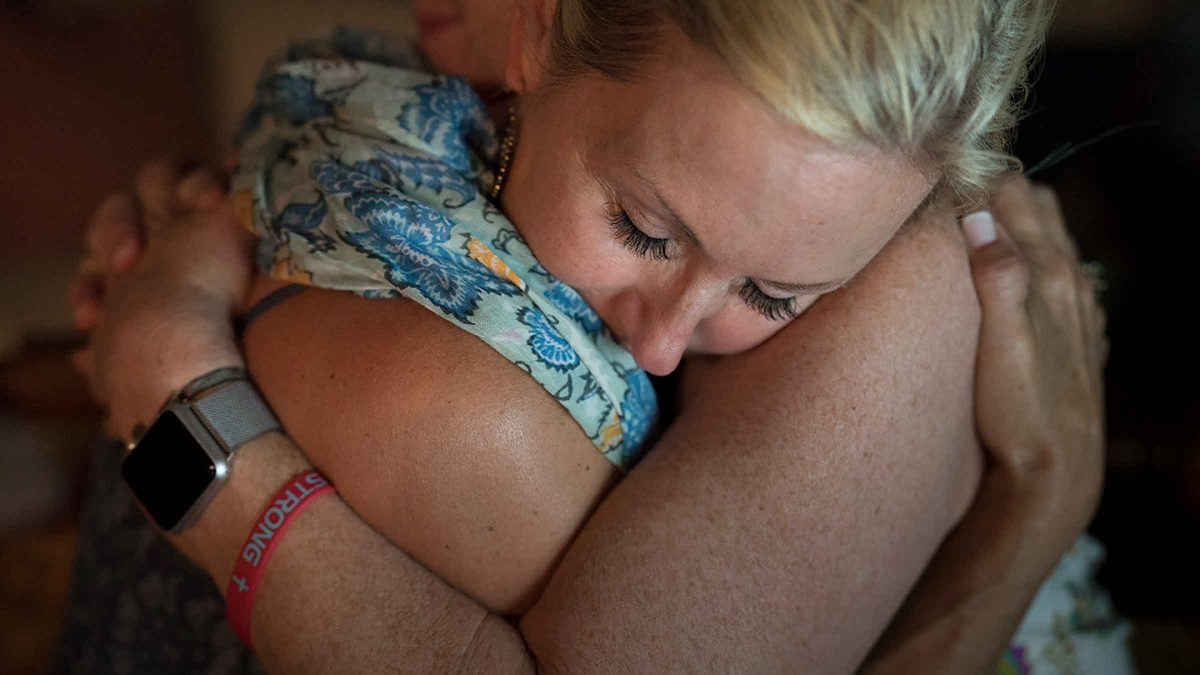Navigating Post-Caregiver Syndrome: Symptoms & Healing

CaringBridge Staff | 04.03.24
Family caregiving is a selfless task that often requires everything you have to give – your emotional strength, your energy and your time. When caregiver duties end, it can be a challenge to rediscover yourself.
It’s normal to feel a range of confusing emotions at this time. Coping with these feelings can sometimes feel impossible. Life is different now, and it can be a big adjustment, especially if you were a family caregiver for an extended period.
Grief, exhaustion, feelings of loss or emotional numbness can cause your life to grind to a halt. If you’re feeling this way, you may be experiencing post-caregiver syndrome. Here, learn more about post-caregiver syndrome and discover some ways to cope.
What Is Post-Caregiver Syndrome?
Post-caregiver syndrome is a state of overwhelm and exhaustion that some family caregivers experience after their loved one – the care recipient – passes away.
Caring for someone near the end of their life can become all-consuming. Once your loved one has passed, it’s common to feel lost and without clear purpose. It can be hard to return to old routines and relearn how to prioritize yourself.
Signs of Post-Caregiver Syndrome

Post-caregiver syndrome is a highly individualized experience that can manifest in many ways. For some, it manifests as anxiety and depression. Others may feel irritable, angry or restless. Here are some common signs you may be experiencing post-caregiver syndrome.
- Guilt: Feeling guilty about how you felt or acted while you were a caregiver is normal. Moments of anger and frustration are very human experiences, even while giving care. It’s important to remember that nobody is perfect and that you did the best job you could.
- Grief: After a loved one dies, it is natural to feel sad, hopeless or even angry. It takes time to process loss, and it’s okay if those feelings keep popping up for a long time.
- Relief: Many people feel a sense of relief after their loved one passes. You’re no longer watching your loved one experience pain, and the responsibility of caring for them has come to an end. This relief might make you feel guilty, but it’s a natural feeling that happens during this process.
- Loss of purpose: Family caregiving can be a full-time job that takes up a lot of energy and emotional bandwidth. It can be difficult to find your way after dedicating so much of your time and energy to something. This is a normal feeling that people experience as they adjust to having more time for themselves.
How to Navigate Post-Caregiver Syndrome: 11 Tips
Transitioning out of being a caregiver can be a challenge that no two people tackle the same way. Navigating these times can be a rollercoaster of emotions, with ups and downs around every corner.
Here are some tips that might help you adjust to life after caregiving:
1. Validate your feelings and experiences
Guilt can make it difficult to acknowledge all the feelings you might be having after your time as a caregiver is over. It’s normal to feel the full range of emotions – regret, numbness, burnout, relief or release.
Validating these feelings is the first step to being able to process them. Journaling, meditating and joining support groups can help you see that what you’re going through is normal and valid.
2. Allow yourself to feel the range of emotions that come
Even after acknowledging them, it can be hard to let yourself feel those emotions. This can be especially true if you’ve been holding them back for a while. Journaling and speaking to others can be one way to express feelings. Some people express their emotions through art or physical movement.
If expressing your emotions doesn’t come naturally or right away, be gentle with yourself. It can take time to find something that works for you.
Tip: Sometimes, it’s hard to know what to say when you’re expressing these feelings. To make things a little easier, CaringBridge is a no-cost health platform that offers writing prompts and thought-starters that you can use to update your support system.
3. Learn how to prioritize yourself

Having time alone can be a big adjustment after spending your life focusing on someone else. It’s normal to feel awkward or selfish, and it might bring back feelings of guilt. Still, it is an important way to adjust to this new season of life.
Caring for yourself and relaxing are important and can be done in different ways. This could mean embracing those small moments, like sipping tea while reading your favorite book. Some people find solace and self-reflection in nature. For others, self-care comes with big events like taking a vacation or “life break” to focus on recovery.
Either return to the self-care practices that have worked before or do your best to discover some new ones.
There’s no need to do it all on your own, either. Counseling, support groups, friends and family support systems can also help you rediscover your own needs. Take it slow and understand that learning and healing take time.
4. Take time to rest and sleep
Post-caregiver syndrome can come with physical and mental exhaustion. Getting enough rest is essential to the healing process.
Unfortunately, even if you’re exhausted, you might still struggle to sleep. It might take time to get back into a good sleep routine because sleep problems are common after stressful events. Sleep-tracking apps, like BetterSleep, can help you manage your sleep issues on your own. If you’re really struggling, you may want to reach out to a medical professional to see if they can help you discover a solution.
5. Practice mindfulness, like meditation or yoga
Meditation and movement can help you regain your sense of self. This can help people rebuild their connection with themselves so they can prioritize their own needs and desires again.
In-person classes are a great option, but lots of informed movement and yoga content can also be found for free online. Meditation doesn’t have to be a formal course, either. Some people connect with themselves by spending time in nature, journaling or deep breathing. Trying different approaches can be helpful if you feel stuck.
Tip: Trauma-informed movement focuses on being aware of (and respecting) your emotions and your body’s needs. There are some YouTube videos that provide free, online versions of trauma-informed yoga classes which can be a good starting point.
6. Keep your to-do list attainable
Immediately after losing a loved one, it might seem like the list of things you need to do is endless. Alerting friends and family, writing an obituary, planning services, and handling administrative tasks with the hospital or government are just some of the many items that may be on your plate.
If you’re feeling overwhelmed, focus on managing just a few tasks at a time. Tasks that have a clear start and finish are easier to take on.
The three-item to-do list method can help you accomplish tasks by filtering them down. Identify the three most important things, write them down, and tackle them before adding more to the list. If three things are still too much, reduce that list to two or even one item.
CaringBridge can help capture support for those practical matters. The Ways to Help section includes tools that let you communicate your needs, whether your most pressing needs are meals, funds or everyday essentials.
Related: 9 Ways to Honor a Loved One Who Has Passed
7. Identify things that give you peace, no matter how small

Sometimes, the small things make the biggest differences. Finding those little moments that give you peace can help you return to a sense of normalcy. You don’t need to jump back into your life immediately. Take small steps to identify things that give you peace and energy, and enter back in gradually.
8. Join or create a post-caregiver support group
Being able to share feelings and experiences with other people can be very healing. This is especially true if they’re going through the same thing.
Post-caregiver support groups are not as common as caregiver groups, but you might find them in the same places. If one doesn’t exist near you, consider creating a group yourself.
It’s important to have an outlet to express your feelings during these times. For example, CaringBridge can be used to journal your experience with post-caregiver syndrome. If you would like to share with others, journaling publicly can help you develop a support community. Posts can also be privatized to keep things within your inner circle.
9. If you’re spiritual, lean into your faith
Whether you prefer to experience faith on your own or with a community, places of worship can help you find peace and support. Spiritual communities can be a good place to find support groups and community resources.
10. If feasible, explore counseling or therapy options
Counseling and therapy can be key to your journey with post-caregiver syndrome. Time and money can make going to therapy more challenging, but there are options. If you can’t go in person, ask about virtual sessions. Many practices offer sliding fees and low-cost options, too.
Tip: Websites like Psychology Today and APA Psychologist Locator may be able to help you find a mental health professional that fits your needs (telehealth, insurance coverage, etc.).
11. Know that you deserve support and that it’s okay to ask for it
Caregiving and the experience afterward can feel isolating. It’s important to remember that you’re a human who deserves support, too. Reach out to your support structure and communities when you need it. It’s not a sign of weakness to ask for help.
What Advice Would You Share?
Navigating life after caregiving can be daunting, but it’s not impossible. With time and intentional self-care, post-caregiver syndrome is something that can be overcome. Setting aside just one hour a week for healing activities can make a big difference.
Finding support and empathy with other people is a good way to remember that you aren’t alone. We encourage you to share your personal experiences with post-caregiver syndrome. What mindsets and activities helped you?